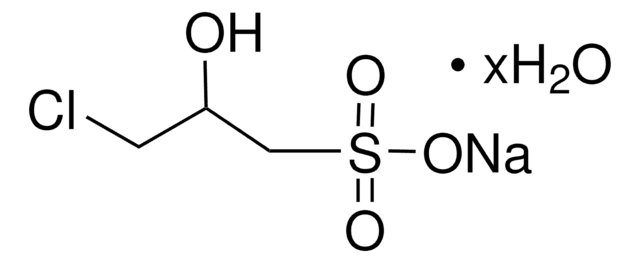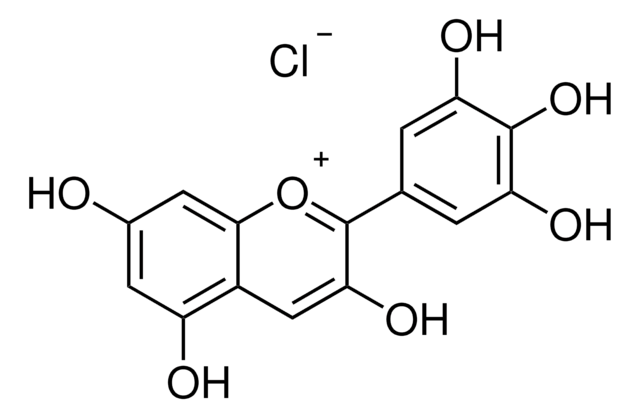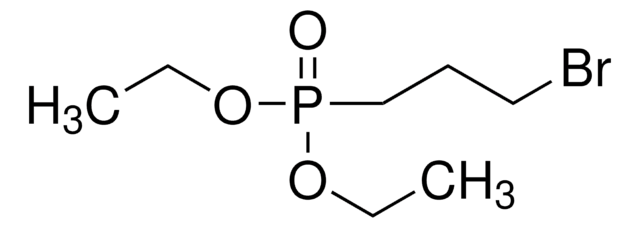137502
Sodium 2-bromoethanesulfonate
98%
Sinônimo(s):
2-Bromoethanesulfonic acid sodium salt
Faça loginpara ver os preços organizacionais e de contrato
About This Item
Fórmula linear:
BrCH2CH2SO3Na
Número CAS:
Peso molecular:
211.01
Beilstein:
4590828
Número CE:
Número MDL:
Código UNSPSC:
12352100
ID de substância PubChem:
NACRES:
NA.22
Produtos recomendados
Nível de qualidade
Ensaio
98%
pf
283 °C (dec.) (lit.)
solubilidade
water: soluble 100 mg/mL, clear, colorless
grupo funcional
bromo
sulfonic acid
cadeia de caracteres SMILES
[Na+].[O-]S(=O)(=O)CCBr
InChI
1S/C2H5BrO3S.Na/c3-1-2-7(4,5)6;/h1-2H2,(H,4,5,6);/q;+1/p-1
chave InChI
HNFOAHXBHLWKNF-UHFFFAOYSA-M
Procurando produtos similares? Visita Guia de comparação de produtos
Descrição geral
Sodium 2-bromoethanesulfonate acts as methanogenesis inhibitor during anaerobic digestion. It reacts with lithium sulfinated polysulfones(PSU) to yield sulfoethylated PSU.
Aplicação
Sodium 2-bromoethanesulfonate(BES) was used to investigate the effect of BES on inhibition of bacterial growth.
Código de classe de armazenamento
13 - Non Combustible Solids
Classe de risco de água (WGK)
WGK 1
Ponto de fulgor (°F)
Not applicable
Ponto de fulgor (°C)
Not applicable
Equipamento de proteção individual
dust mask type N95 (US), Eyeshields, Gloves
Escolha uma das versões mais recentes:
Já possui este produto?
Encontre a documentação dos produtos que você adquiriu recentemente na biblioteca de documentos.
Os clientes também visualizaram
Yu Yang et al.
Water research, 47(17), 6790-6800 (2013-10-12)
Nano zero valent iron (NZVI), although being increasingly used for environmental remediation, has potential negative impact on methanogenesis in anaerobic digestion. In this study, NZVI (average size = 55 ± 11 nm) showed inhibition of methanogenesis due to its disruption
J Sipma et al.
Applied microbiology and biotechnology, 64(3), 421-428 (2003-10-14)
The conversion routes of carbon monoxide (CO) at 55 degrees C by full-scale grown anaerobic sludges treating paper mill and distillery wastewater were elucidated. Inhibition experiments with 2-bromoethanesulfonate (BES) and vancomycin showed that CO conversion was performed by a hydrogenogenic
Oleg R Kotsyurbenko et al.
Environmental microbiology, 6(11), 1159-1173 (2004-10-14)
Sites in the West Siberian peat bog 'Bakchar' were acidic (pH 4.2-4.8), low in nutrients, and emitted CH4 at rates of 0.2-1.5 mmol m(-2) h(-1). The vertical profile of delta13CH4 and delta13CO2 dissolved in the porewater indicated increasing isotope fractionation
Kewei Xu et al.
Applied microbiology and biotechnology, 87(6), 2267-2279 (2010-06-19)
The effects of two typical methanogenic inhibitors [2-bromoethanesulfonate (BES) and chloroform (CHCl(3))] on the bacterial populations were investigated using molecular ecological techniques. Terminal restriction fragment length polymorphism analyses (T-RFLP) in combination with clone library showed that both the toxicants not
Tao Yan et al.
FEMS microbiology ecology, 55(2), 248-261 (2006-01-20)
Anaerobic cultures capable of reductively dechlorinating 2,3,4,5-tetrachlorobiphenyl (CB) were enriched from three different sediments, one estuarine, one marine and one riverine. Two different electron donors were used in enrichments with the estuarine sediment (elemental iron or a mixture of fatty
Nossa equipe de cientistas tem experiência em todas as áreas de pesquisa, incluindo Life Sciences, ciência de materiais, síntese química, cromatografia, química analítica e muitas outras.
Entre em contato com a assistência técnica








